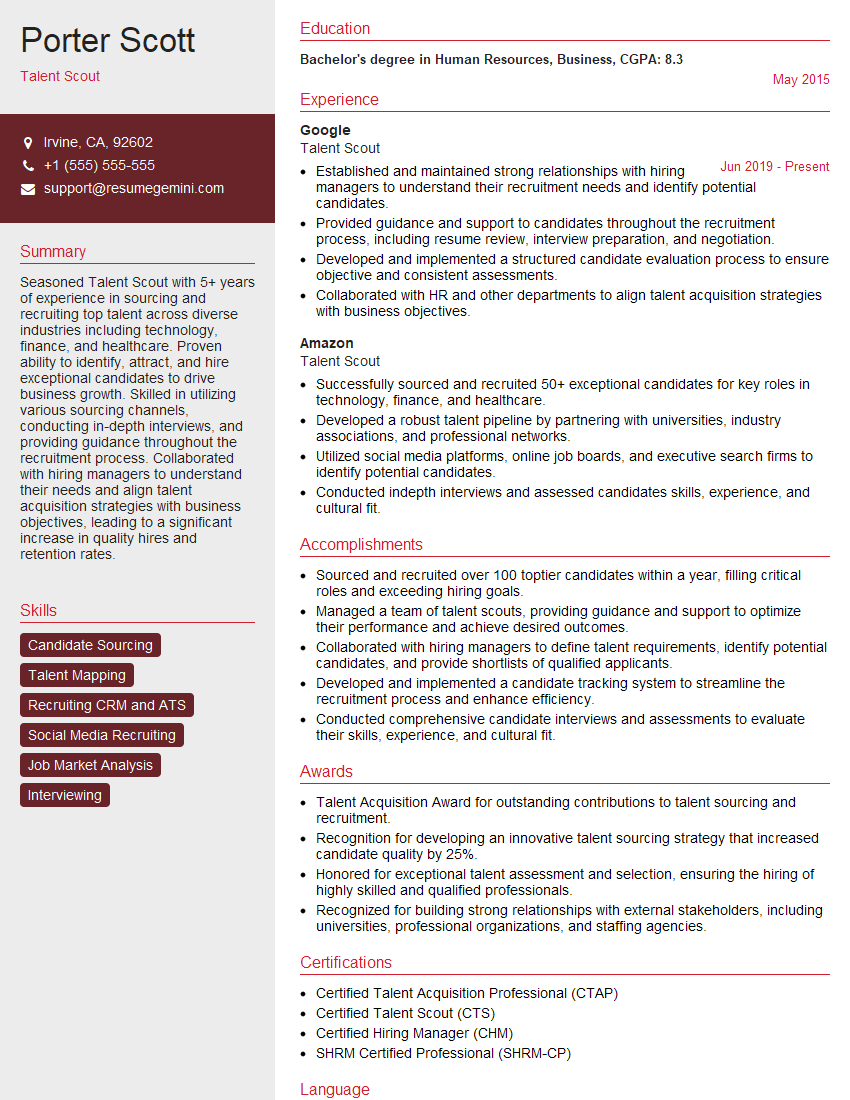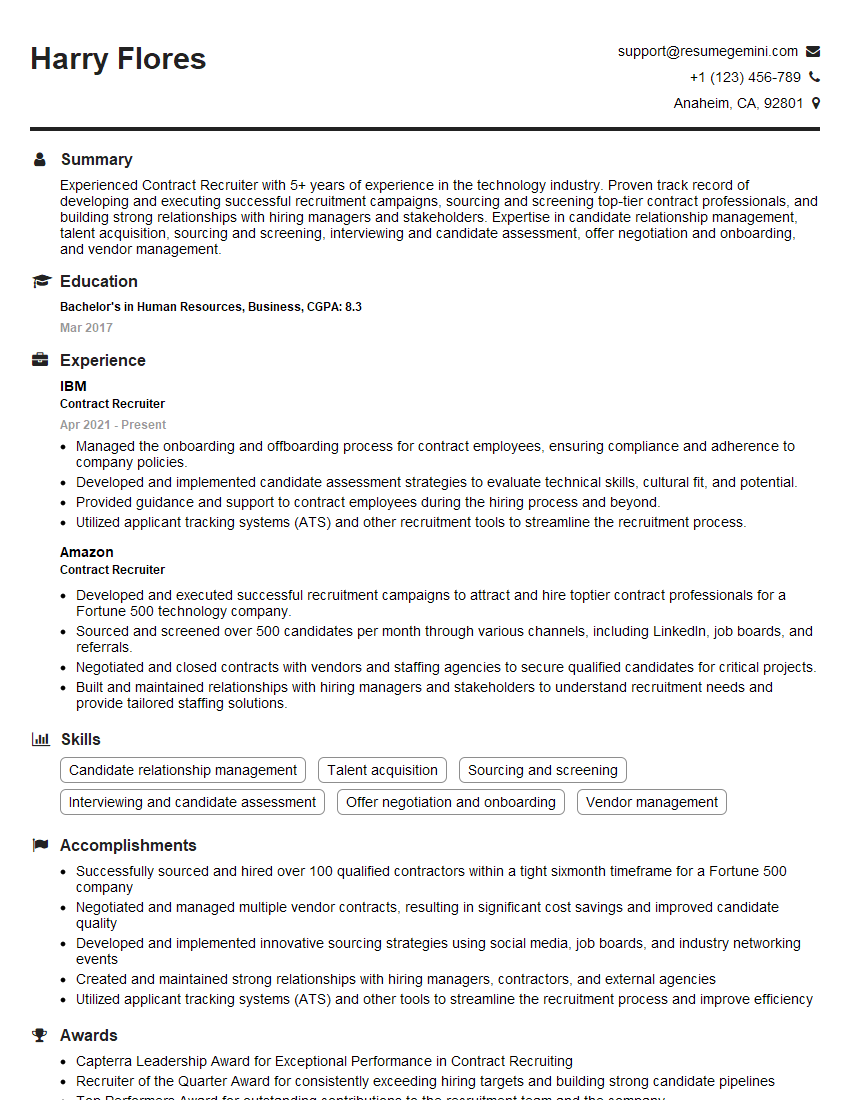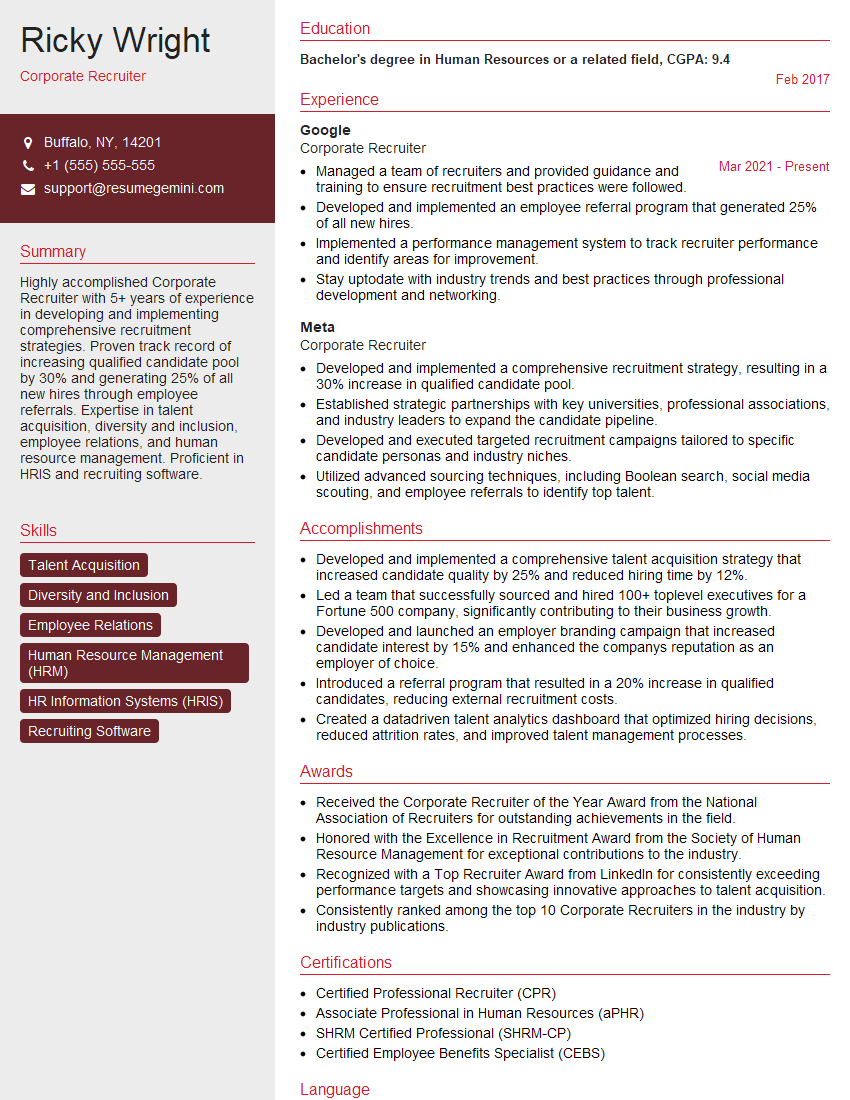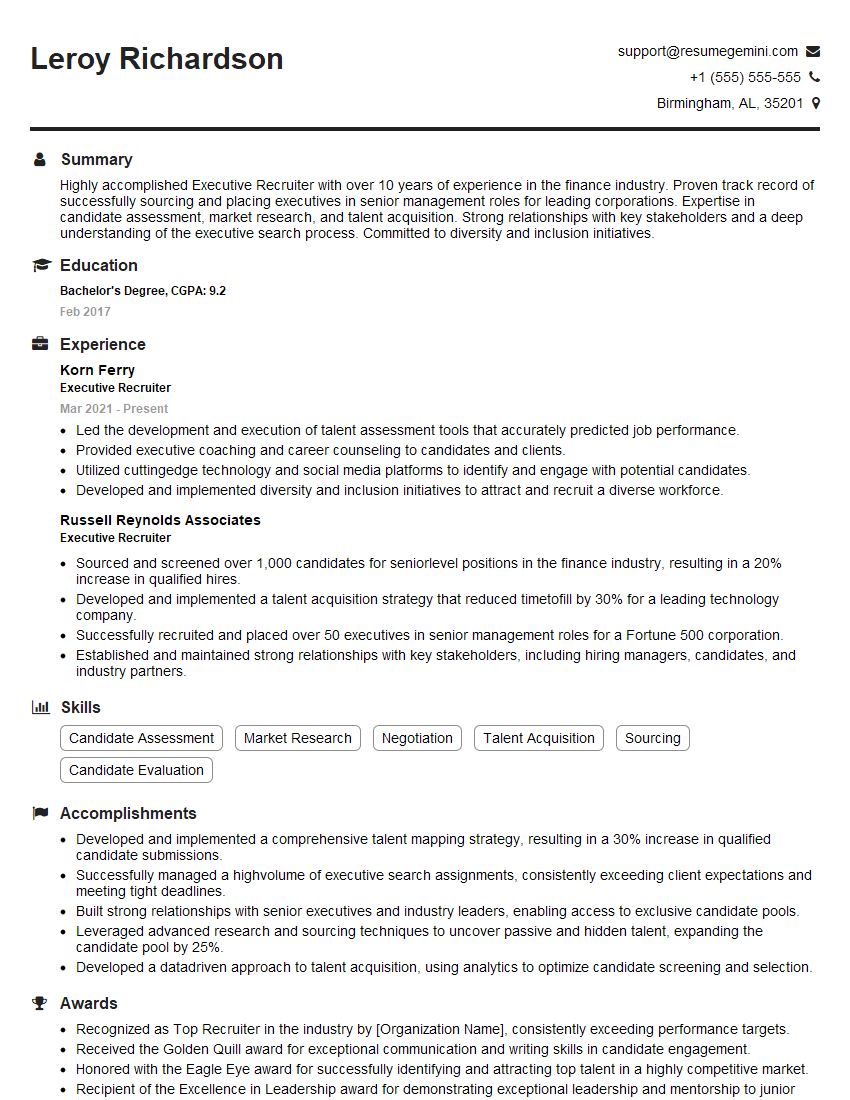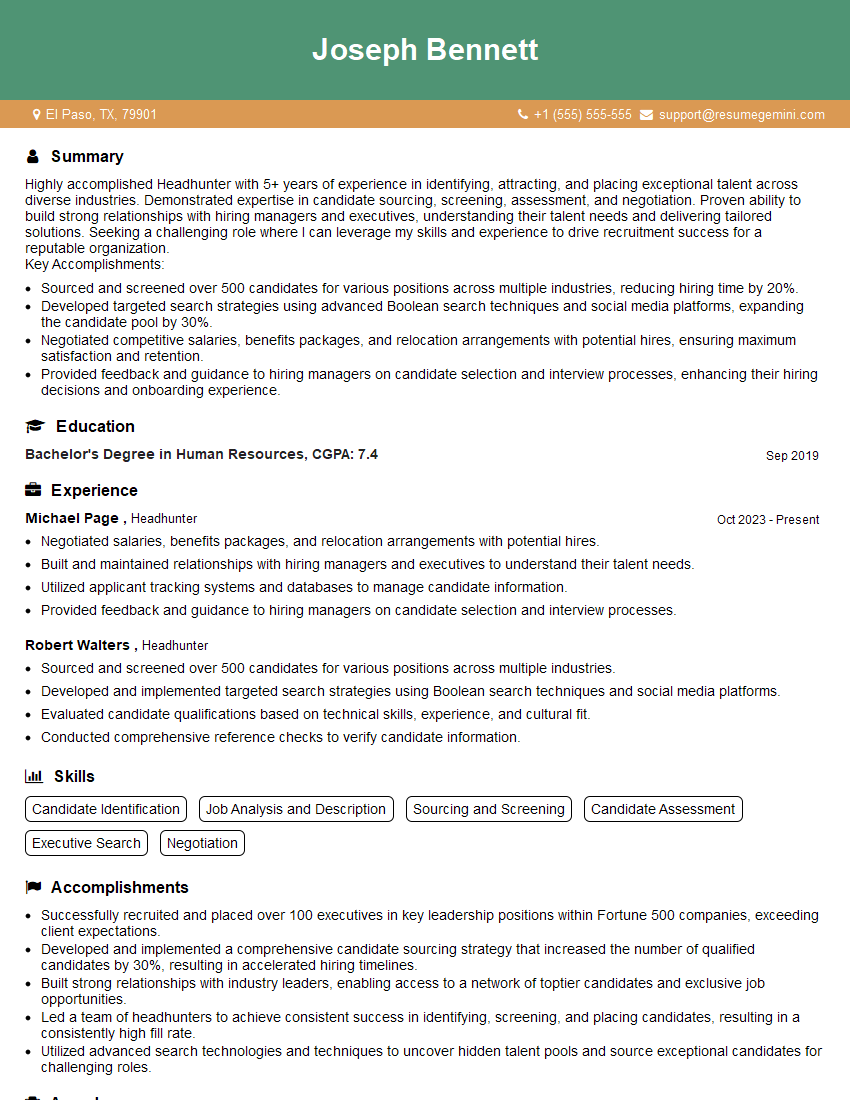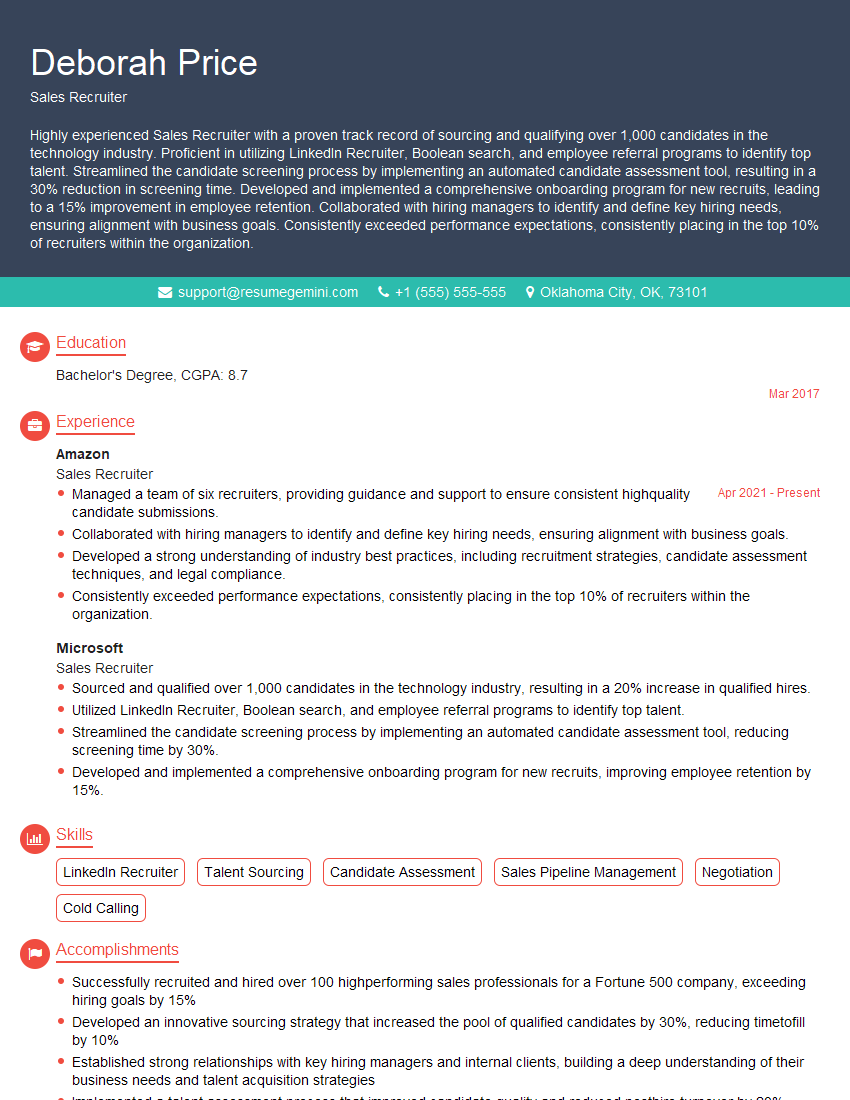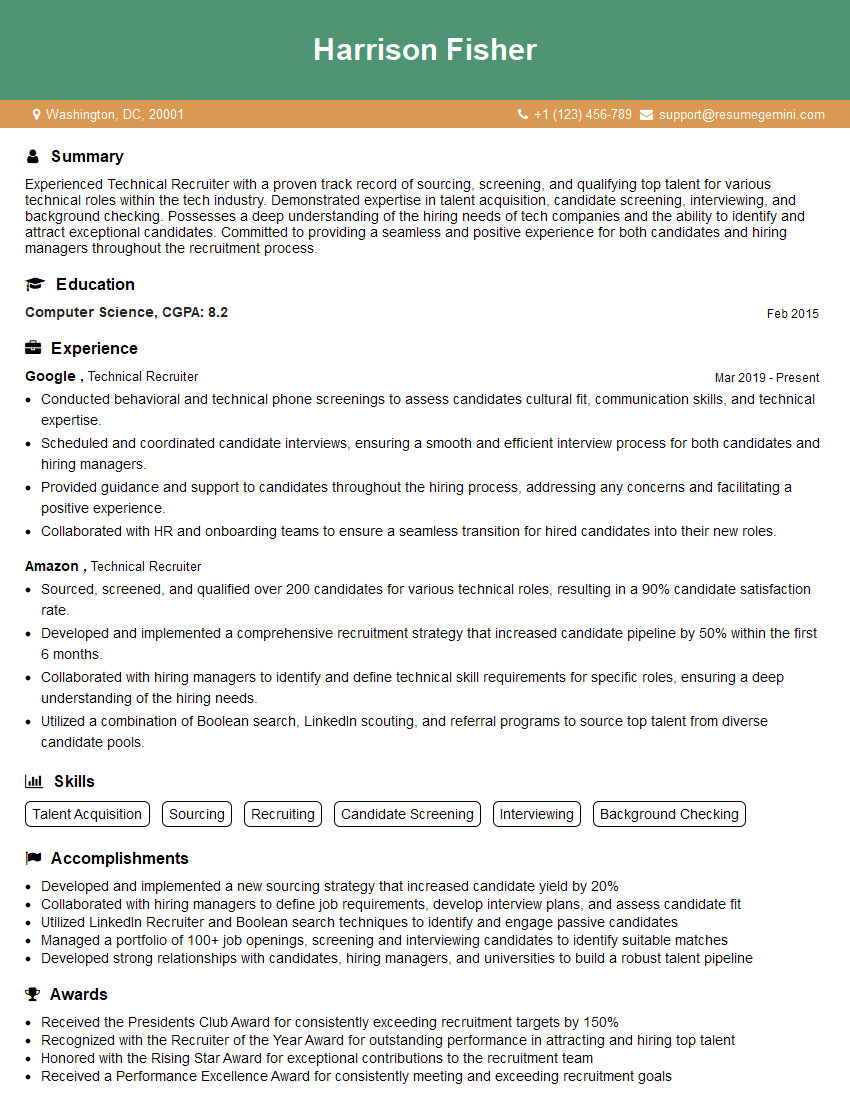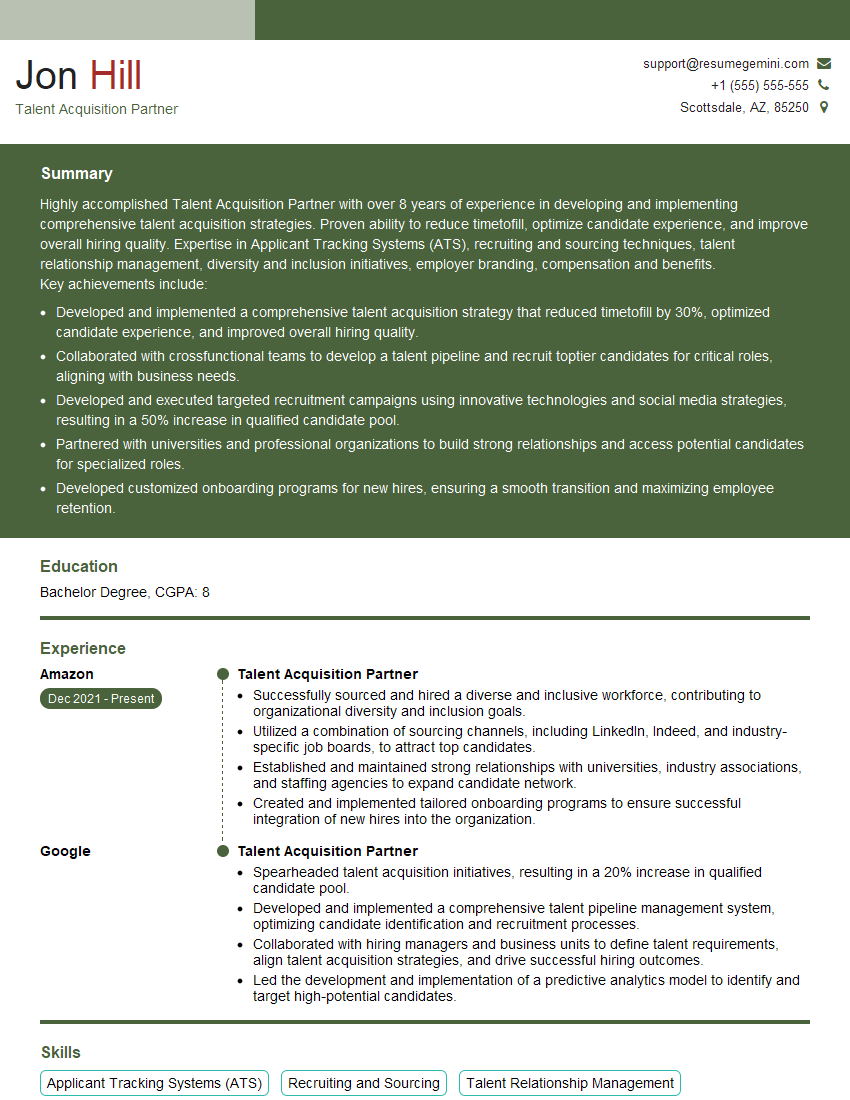Interviews are opportunities to demonstrate your expertise, and this guide is here to help you shine. Explore the essential Scouting and Recruiting for Talent Acquisition interview questions that employers frequently ask, paired with strategies for crafting responses that set you apart from the competition.
Questions Asked in Scouting and Recruiting for Talent Acquisition Interview
Q 1. Describe your experience with various sourcing techniques (e.g., Boolean search, LinkedIn Recruiter, networking).
Sourcing talent effectively is the cornerstone of successful recruiting. My approach leverages a multi-faceted strategy combining various techniques. Boolean search, for instance, allows me to pinpoint ideal candidates within large databases like LinkedIn. I regularly use complex Boolean strings, such as "(Sales OR Marketing) AND (Senior Manager OR Director) AND LinkedIn" to refine my searches and target specific profiles. LinkedIn Recruiter is another indispensable tool; I use its advanced search filters and engagement features to proactively connect with passive candidates who might not be actively looking for new opportunities. This includes meticulously crafting personalized connection requests that highlight mutual connections or shared professional interests. Finally, networking is crucial. I actively participate in industry events, conferences, and online forums, building relationships with potential candidates and hiring managers alike. This often leads to uncovering hidden talent pools and gaining valuable market insights.
For example, recently I needed a data scientist with experience in a specific natural language processing (NLP) library. Instead of relying solely on keywords, I utilized Boolean search strings combining experience levels, specific tools and project scopes within various job boards and professional platforms to secure a high-quality candidate pool.
Q 2. Explain your process for evaluating candidates’ resumes and cover letters.
Evaluating resumes and cover letters is a critical step, demanding a keen eye for detail and a systematic approach. I start by assessing the overall clarity and presentation – a well-structured document speaks volumes about the candidate’s organizational skills. Then, I delve into the content, focusing on the candidate’s career progression, highlighting achievements and quantifiable results wherever possible. I’m not just looking for a list of tasks but for demonstrable impact. For example, instead of ‘Managed social media accounts,’ I look for ‘Increased social media engagement by 25% in six months through targeted campaigns’. Finally, I cross-reference information provided in the resume and cover letter to ensure consistency and identify any potential red flags.
Cover letters give me insights into the candidate’s personality and communication style. I pay attention to the candidate’s articulation of their career goals and how they align with the specific job requirements. A well-written cover letter can significantly enhance a candidate’s profile.
Q 3. How do you prioritize candidates based on their skills and experience?
Prioritizing candidates requires a balanced approach, considering both hard and soft skills. I use a scoring system, assigning weights to different criteria based on the job description’s requirements. For instance, a senior engineering role might prioritize technical expertise (weighted heavily) alongside leadership qualities (weighted moderately). I create a matrix where each skill is assessed and scored based on the candidate’s resume and interview performance. This allows for objective comparison and prioritization. I also account for cultural fit and long-term potential, as these factors are crucial for sustained success within the organization. Candidates who demonstrate a strong alignment with the company’s values and possess a clear career trajectory get prioritized.
For example, in a recent search for a project manager, technical expertise was given a 40% weight, leadership skills 30%, communication skills 20%, and cultural fit 10%. This allowed for a structured comparison of candidates with diverse backgrounds.
Q 4. What metrics do you use to measure the success of your recruiting efforts?
Measuring recruiting success goes beyond simply filling open positions. I utilize a range of metrics to assess the effectiveness of my efforts. Key metrics include time-to-hire, cost-per-hire, and quality-of-hire. Time-to-hire measures the efficiency of the recruitment process. Cost-per-hire helps determine the overall cost-effectiveness. Quality-of-hire is assessed through performance reviews, employee retention rates, and feedback from hiring managers regarding the candidate’s contribution to the team and the organization. Furthermore, I track sourcing channel effectiveness to understand which channels deliver the best candidates for specific roles, which informs future sourcing strategies. Finally, candidate experience is a crucial metric; I collect feedback to continuously improve the candidate journey.
Q 5. Describe your experience with applicant tracking systems (ATS).
Applicant Tracking Systems (ATS) are integral to modern recruiting. My experience with various ATS platforms, including Taleo, Workday, and Greenhouse, is extensive. I’m proficient in using ATS for candidate sourcing, managing applications, scheduling interviews, and tracking the progress of each candidate throughout the recruitment pipeline. Beyond basic functionality, I utilize advanced features like reporting and analytics to track key metrics, optimize workflow, and improve the overall recruiting process. I understand the importance of properly tagging and categorizing candidate data to facilitate efficient searches and reporting. Effective use of an ATS streamlines the entire process, saving time and resources while ensuring a more organized and efficient approach.
Q 6. How do you build and maintain relationships with hiring managers?
Building and maintaining strong relationships with hiring managers is paramount. I achieve this through proactive communication, regular updates, and a collaborative approach. Before starting a search, I have thorough discussions with hiring managers to gain a deep understanding of the role’s requirements, team dynamics, and company culture. I provide regular updates on the progress of the search, highlighting potential candidates and addressing any concerns. I also leverage data and insights from the ATS to demonstrate the effectiveness of the recruitment strategy. By actively listening to their feedback and addressing their needs, I ensure alignment and foster trust, converting them into active partners in the recruitment process. Regular one-on-one meetings ensure open communication and collaborative decision-making.
Q 7. How do you handle challenging situations with candidates or hiring managers?
Handling challenging situations requires diplomacy, empathy, and a problem-solving mindset. When dealing with difficult candidates, I strive to maintain open and honest communication, addressing their concerns and providing constructive feedback. For instance, if a candidate is unresponsive or demanding, I would reiterate expectations for communication and professional conduct while being respectful and understanding. With difficult hiring managers, I work collaboratively to understand their concerns and strive to find mutually agreeable solutions. Maintaining clear communication, providing supporting data (e.g., candidate assessment results), and providing alternative solutions all help navigate these challenges. Sometimes, escalation to senior management is necessary to find a resolution that respects all parties involved.
A calm and measured approach, a commitment to clear communication and active listening are my primary tools in resolving challenging situations.
Q 8. What is your approach to diversity and inclusion in recruiting?
My approach to diversity and inclusion in recruiting is proactive and multifaceted. It’s not just about meeting quotas; it’s about building a truly representative and inclusive workforce where everyone feels valued and respected. This starts with crafting inclusive job descriptions that avoid gendered or biased language, and actively sourcing candidates from diverse backgrounds.
I leverage diverse sourcing channels, such as partnering with organizations focused on underrepresented groups, attending industry events that attract diverse talent, and utilizing job boards and platforms that actively promote diversity. Furthermore, I implement blind resume screening to mitigate unconscious bias during the initial screening process. Finally, I actively participate in diversity and inclusion training to enhance my own awareness and understanding of best practices.
For example, in a recent search for software engineers, I partnered with a local organization that supports women in technology, resulting in a significantly more diverse applicant pool than previous searches for similar roles. This led to the hiring of an exceptionally talented engineer who brought a unique perspective and skillset to the team.
Q 9. Describe your experience with different interview techniques (e.g., behavioral, technical, panel).
I’m proficient in various interview techniques, tailoring my approach to the specific role and candidate. Behavioral interviews are crucial for assessing soft skills and cultural fit. I use the STAR method (Situation, Task, Action, Result) to guide candidates in providing structured and insightful responses. For example, I might ask, “Tell me about a time you had to deal with a conflict within a team.”
Technical interviews are essential for evaluating hard skills, often involving coding challenges, problem-solving exercises, or scenario-based questions relevant to the specific technical requirements of the position. Panel interviews provide a holistic perspective, involving multiple interviewers who assess different aspects of the candidate’s profile, minimizing individual biases. In some situations, I even incorporate situational judgment tests, which evaluate candidates’ decision-making abilities under pressure.
My experience demonstrates that a combination of these techniques yields the most comprehensive candidate assessment, ensuring a robust selection process. I strive to create a comfortable environment during each interview, fostering open communication and ensuring candidates feel heard.
Q 10. How do you ensure a positive candidate experience throughout the recruitment process?
A positive candidate experience is paramount to attracting top talent and building a strong employer brand. This starts with prompt communication throughout the entire process – acknowledging applications, providing updates on timelines, and offering clear feedback regardless of the outcome.
I ensure consistent and timely communication via email and phone, providing candidates with a realistic understanding of the timeline and the next steps. I also focus on creating a welcoming and professional environment during interviews, ensuring the interviewer and interviewee feel comfortable. Finally, I always send a thank-you note following each interview, regardless of the outcome.
In one instance, a candidate appreciated the detailed feedback they received even after not being selected. This led to them recommending our company to their network in the future.
Q 11. How do you identify and attract passive candidates?
Identifying and attracting passive candidates—those not actively seeking new jobs—requires a strategic approach. It involves leveraging professional networking sites like LinkedIn, attending industry events, and participating in online communities relevant to the target roles.
I actively build and maintain relationships within my network, always keeping an eye out for individuals with relevant skills and experience. I also utilize LinkedIn Recruiter to search for individuals with specific skillsets and reach out to them directly with personalized messages outlining the opportunity and the company’s value proposition.
For instance, I once identified a highly sought-after data scientist through LinkedIn, who wasn’t actively searching for a new position. By showcasing our company’s innovative work in the field and emphasizing the team’s collaborative environment, I successfully persuaded them to consider the opportunity, leading to a successful placement.
Q 12. Explain your experience with negotiating salaries and benefits packages.
Salary and benefits negotiation requires thorough preparation and a collaborative approach. I begin by researching industry benchmarks to determine a competitive salary range for the position. I use this information to inform my discussions with the candidate and hiring manager, ensuring the offer is fair and aligns with the candidate’s expectations and the company’s budget.
I clearly communicate the total compensation package, including base salary, benefits, bonuses, and any other incentives, explaining each component thoroughly. I approach negotiations as a discussion, aiming to find a mutually beneficial solution that meets both the candidate’s needs and the company’s constraints.
For example, if a candidate is focused on a specific benefit (e.g., professional development opportunities), I might propose adjusting the compensation package accordingly. A balanced approach to negotiation ensures a positive outcome for both sides, leading to a stronger employment relationship.
Q 13. How do you handle situations where you have multiple qualified candidates?
Having multiple qualified candidates is a positive challenge. To make a decision, I use a structured evaluation process, typically involving a weighted scoring system. Each candidate is assessed against pre-defined criteria aligned with the job description, such as technical skills, experience, cultural fit, and communication skills.
These criteria are weighted according to their importance for the role. For instance, in a highly technical role, technical skills might carry a higher weight than in a customer-facing position. The candidate with the highest overall score is typically selected.
If the scores are very close, I may involve additional stakeholders in the final decision-making process, ensuring a thorough evaluation and a fair selection. This methodical approach ensures a data-driven decision and minimizes potential biases.
Q 14. Describe your experience with background checks and reference checks.
Background checks and reference checks are essential components of the hiring process. Background checks are usually conducted by a third-party vendor, ensuring compliance with legal regulations and company policies. These typically involve criminal record checks, education verification, and employment history verification. Reference checks involve contacting previous employers or supervisors to confirm a candidate’s employment history, job performance, and overall suitability for the role.
I prepare a structured set of questions to ask each reference, ensuring consistency and relevant information. I also clearly communicate the purpose of the reference check and ensure the candidate’s consent before contacting their references.
My approach to both background and reference checks is meticulous and ensures compliance with all legal and ethical considerations, ultimately minimizing risk and protecting the company and the candidate.
Q 15. How do you stay up-to-date on industry trends and best practices in recruiting?
Staying ahead in the dynamic world of recruiting requires a multi-pronged approach. It’s not just about reading industry publications; it’s about active participation and continuous learning.
Industry Publications and Conferences: I regularly read publications like SHRM (Society for Human Resource Management) publications, Recruiting Daily, and ERE (Employee Recruiting Exchange) and attend industry conferences like SHRM Annual Conference & Expo or smaller niche events focusing on specific recruiting methodologies. This ensures I’m exposed to cutting-edge research, innovative strategies, and best practices.
Networking and Professional Organizations: Active participation in professional organizations like the Association for Talent Development (ATD) or local recruiting groups facilitates knowledge sharing and collaborative learning. Engaging with peers allows me to learn from their experiences and challenges, broadening my perspective.
Online Resources and Webinars: Platforms like LinkedIn Learning, Coursera, and Udemy offer valuable courses and webinars on various aspects of recruiting, from AI-driven tools to diversity and inclusion strategies. I regularly dedicate time to explore relevant content and update my skills.
Benchmarking and Competitive Analysis: I actively research competitors’ recruiting strategies, studying their employer branding, candidate experience, and sourcing techniques. This helps identify trends and understand what makes a recruitment strategy successful in the current market.
Career Expert Tips:
- Ace those interviews! Prepare effectively by reviewing the Top 50 Most Common Interview Questions on ResumeGemini.
- Navigate your job search with confidence! Explore a wide range of Career Tips on ResumeGemini. Learn about common challenges and recommendations to overcome them.
- Craft the perfect resume! Master the Art of Resume Writing with ResumeGemini’s guide. Showcase your unique qualifications and achievements effectively.
- Don’t miss out on holiday savings! Build your dream resume with ResumeGemini’s ATS optimized templates.
Q 16. What is your experience with employer branding and recruitment marketing?
Employer branding and recruitment marketing are intertwined and critical for attracting top talent. Employer branding is about crafting a compelling narrative of what it’s like to work for an organization, while recruitment marketing is the strategic use of channels to reach potential candidates and tell that story.
Experience with Employer Branding: In my previous role, I led the effort to revamp our employer brand, focusing on showcasing our company culture, values, and employee testimonials. We utilized employee spotlights on social media, updated our careers page with engaging content, and partnered with employee resource groups to authentically convey our diversity and inclusion initiatives. This improved our candidate perception and increased applications from qualified candidates.
Recruitment Marketing Strategies: My experience encompasses utilizing a range of recruitment marketing channels, including LinkedIn Recruiter, job boards (Indeed, Monster, etc.), social media campaigns (targeted ads on LinkedIn, Twitter, and Instagram), and content marketing (blog posts, articles, and infographics addressing candidate pain points and highlighting company culture). I also have experience with programmatic advertising for targeted candidate outreach.
Measuring Success: I track the success of recruitment marketing through key metrics like cost-per-hire, time-to-hire, application volume, source-of-hire, and candidate engagement rates on our social media and careers page. By analyzing these metrics, I identify what’s working and what needs adjustment.
Q 17. How do you measure the ROI of your recruiting efforts?
Measuring ROI in recruiting is crucial to justify resource allocation and demonstrate the effectiveness of your strategies. It’s not simply about the number of hires; it’s about the quality of those hires and their long-term contribution.
Cost-per-Hire (CPH): This metric calculates the total cost of recruiting divided by the number of hires made. A lower CPH indicates a more efficient recruiting process.
CPH = Total Recruiting Costs / Number of HiresTime-to-Hire (TTH): This measures the time taken from posting a job to extending an offer. A shorter TTH reflects a more efficient and effective recruitment process.
Quality of Hire: This is a more subjective but critical metric. It involves assessing the performance and retention rate of new hires. Higher performance and retention rates demonstrate the effectiveness of the selection process.
Return on Investment (ROI): This metric considers the financial impact of new hires on the company’s profitability.
ROI = (Revenue Generated by New Hires - Total Recruiting Costs) / Total Recruiting Costs. This requires projecting the revenue contribution of new employees over a specific period.
By analyzing these metrics together, we gain a holistic understanding of the ROI of our recruiting efforts.
Q 18. How do you use data analytics to improve your recruiting strategies?
Data analytics is no longer optional; it’s essential for effective recruiting. By leveraging data, we can identify patterns, optimize processes, and make data-driven decisions.
Applicant Tracking System (ATS) Data: I use ATS data to track source of hire, time to fill, application completion rates, and candidate flow to identify bottlenecks and areas for improvement.
Recruitment Marketing Analytics: I analyze data from social media campaigns, job boards, and email marketing to assess the effectiveness of different channels and optimize our outreach strategies.
Candidate Experience Surveys: I regularly gather feedback from candidates through surveys to understand their experience throughout the recruitment process. This helps identify areas for improvement and enhance candidate satisfaction.
Predictive Analytics: I utilize predictive analytics tools to identify candidates most likely to be successful based on various factors like skills, experience, and cultural fit. This helps improve the quality of hire and reduce time-to-fill.
By combining these data sources, I create a comprehensive picture of our recruitment performance, which allows for continuous optimization and strategic adjustments.
Q 19. Describe a time you had to adapt your recruiting strategy due to unforeseen circumstances.
During a period of rapid company growth, we experienced an unexpected surge in open positions. Our existing recruitment strategy, which relied heavily on traditional job boards, wasn’t scaling efficiently. We needed to adapt quickly to meet the increased demand.
Problem: The existing approach was slow and expensive, resulting in longer time-to-hire and higher cost-per-hire.
Solution: We implemented a multi-pronged approach:
Expanded Sourcing Channels: We diversified our sourcing by leveraging social media recruitment, employee referrals, and partnering with specialized recruitment agencies.
Streamlined Application Process: We simplified our application process to reduce friction and improve candidate experience. This included a more user-friendly careers page and a quicker initial screening process.
Leveraged Technology: We implemented a more robust applicant tracking system (ATS) with advanced features for better candidate management and tracking.
Results: This adapted strategy significantly reduced our time-to-hire and cost-per-hire, enabling us to fill the increased number of positions effectively and efficiently. The streamlined application process also improved candidate satisfaction and our employer brand reputation.
Q 20. How do you build strong relationships with external recruiters and agencies?
Building strong relationships with external recruiters and agencies is crucial for accessing a wider talent pool and gaining access to specialized expertise.
Regular Communication: I maintain consistent communication with my preferred agencies through regular calls, emails, and in-person meetings. This keeps them informed about our hiring needs and ensures they understand our company culture and values.
Providing Feedback: I provide constructive feedback on their performance, both positive and negative. This transparency helps them improve their service and strengthens our partnership.
Transparency and Trust: I’m transparent about our hiring process and expectations, fostering trust and mutual respect. Open communication builds stronger, more productive relationships.
Shared Success: I actively celebrate successes with my agency partners and acknowledge their contribution to our hiring achievements. This mutual recognition fosters a collaborative and supportive relationship.
Mutual Respect: Treating them as trusted partners, not just vendors, strengthens the relationship and improves the quality of service.
By nurturing these relationships, I ensure access to a broader range of talent and gain valuable insights into the market dynamics.
Q 21. How do you handle candidate rejection and manage their expectations?
Rejecting candidates is a necessary but challenging part of the recruiting process. It’s crucial to handle rejections with professionalism and empathy to maintain a positive candidate experience.
Timely Communication: I make sure to communicate the outcome of applications promptly, avoiding lengthy periods of silence. Candidates deserve a clear and timely response, regardless of the decision.
Personalized Rejection Messages: I craft personalized messages explaining the reasons for the rejection, focusing on specific skills or experience gaps rather than generalized statements. This provides constructive feedback and helps candidates improve their future applications.
Empathy and Respect: I approach rejection conversations with empathy and respect, acknowledging the time and effort candidates have invested in the process. This approach fosters goodwill and enhances the employer brand.
Future Opportunities: In some cases, I may express interest in keeping their application on file for future suitable opportunities. This leaves the door open for future consideration and maintains a positive connection.
By handling rejections professionally, we preserve the candidate experience, protect our employer brand, and maintain a positive relationship with potential future applicants.
Q 22. What is your approach to ensuring compliance with employment laws and regulations?
Ensuring compliance with employment laws and regulations is paramount in talent acquisition. My approach is proactive and multi-faceted, starting with a thorough understanding of all applicable federal, state, and local laws, including those related to equal opportunity employment, non-discrimination, background checks, and wage and hour regulations. I regularly update myself on legal changes through professional development and resources like SHRM (Society for Human Resource Management) publications and legal consultations.
Practical Application: Before launching any recruitment campaign, I meticulously review the job description to ensure it’s compliant, avoiding potentially discriminatory language. For example, instead of specifying age, I focus on experience. I also work closely with our legal team to review all recruitment materials and processes, ensuring they adhere to all relevant laws. For background checks, I only utilize reputable, compliant third-party vendors and ensure candidates are informed and consent to the process.
Example: During a recent recruitment drive, we discovered a clause in our application form that might have inadvertently violated the Americans with Disabilities Act (ADA). I immediately flagged this, worked with the legal team to amend the form, and re-launched the recruitment with the updated, compliant version.
Q 23. Describe your experience with different recruitment channels (e.g., job boards, social media, referrals).
My experience with various recruitment channels is extensive. I leverage a multi-channel strategy, recognizing that different platforms attract different talent pools.
- Job Boards: I utilize major platforms like Indeed, LinkedIn Recruiter, and specialized job boards tailored to specific industries. I optimize job postings with relevant keywords to improve visibility and attract qualified candidates. I carefully analyze the performance of each job board to determine ROI and adjust our strategy accordingly.
- Social Media: LinkedIn is crucial for engaging with passive candidates. I use it to build my professional network, participate in relevant groups, and share engaging content related to our company and the industry. Targeted advertising campaigns on LinkedIn and other platforms allow me to reach specific demographics.
- Referrals: Employee referrals are a highly effective channel. I actively encourage employee participation through referral bonus programs and clear communication regarding the referral process. This fosters a sense of ownership and improves the quality of hires.
Practical Application: A recent engineering role was filled through a successful LinkedIn Recruiter campaign, where we targeted individuals with specific skill sets and experience levels. We also had considerable success filling several sales roles through employee referrals, demonstrating the power of internal networking.
Q 24. How do you assess candidates’ cultural fit with the company?
Assessing cultural fit is crucial for long-term employee success and retention. It’s not about finding clones; it’s about identifying individuals whose values, work styles, and communication preferences align with our company culture. My approach is a multi-step process.
- Behavioral Interviewing: I use behavioral questions to understand how candidates have handled situations in the past, revealing their work ethic, teamwork skills, and problem-solving approaches. For example, “Tell me about a time you had to deal with a difficult colleague.”
- Team Interactions: When appropriate, I include opportunities for candidates to interact with potential team members. This provides a more realistic view of the day-to-day dynamics and helps gauge interpersonal compatibility.
- Company Value Alignment: I explicitly discuss our company values during the interview process and explore how the candidate’s values resonate with ours. I might present a scenario reflecting a company value and ask how they would approach it.
Example: During an interview, I observed a candidate who showed exceptional technical skills but lacked collaborative spirit. Their responses to behavioral questions revealed a preference for independent work, which might not be suitable for a team-oriented role. This helped us make an informed decision despite their strong technical qualifications.
Q 25. What is your experience with onboarding new hires?
Onboarding is critical for new hire success and retention. My experience includes designing and implementing comprehensive onboarding programs that encompass both administrative tasks and experiential learning.
- Pre-boarding: Before the start date, I ensure all necessary paperwork is completed and the new hire receives all relevant information, including IT access, benefits enrollment instructions, and a welcome package.
- First Day/Week: The first day is crucial for establishing a positive first impression. This includes introductions to the team, a tour of the facilities, and a clear overview of the role and expectations.
- Ongoing Support: I provide regular check-ins during the first few months to address any questions or concerns, offer support and guidance, and ensure a smooth transition into the role. I also incorporate regular feedback sessions and opportunities for professional development.
Example: I recently implemented a buddy system where new hires are paired with an experienced colleague who acts as a mentor and provides ongoing support during the initial months. This has significantly improved new hire engagement and retention.
Q 26. How do you handle sensitive information during the recruitment process?
Handling sensitive information during the recruitment process requires strict adherence to confidentiality protocols and data privacy regulations like GDPR and CCPA. My approach emphasizes secure data handling at every stage.
- Data Encryption: All sensitive candidate data is encrypted both in transit and at rest, utilizing secure platforms and tools.
- Access Control: Access to candidate information is strictly limited to authorized personnel on a need-to-know basis.
- Data Minimization: I only collect the necessary data required for the recruitment process, avoiding unnecessary information.
- Secure Disposal: All sensitive documents are securely disposed of after the recruitment process is complete.
Example: I would never store sensitive candidate information in unencrypted formats on shared drives or personal devices. I always use secure applicant tracking systems and follow strict data handling procedures as defined by company policy and legal requirements.
Q 27. What is your experience with talent mapping and workforce planning?
Talent mapping and workforce planning are essential for proactive talent acquisition. Talent mapping involves identifying and assessing the skills and capabilities within an organization and the external talent pool. Workforce planning focuses on aligning the organization’s talent with its strategic objectives.
- Skill Gap Analysis: I conduct skill gap analyses to identify areas where the organization lacks the necessary talent to meet current and future needs.
- Succession Planning: I participate in succession planning to identify high-potential employees and develop strategies to ensure smooth transitions into leadership roles.
- Future Skill Needs Forecasting: I collaborate with business leaders to anticipate future talent needs based on market trends, technological advancements, and business strategy.
Example: Through talent mapping, we recently identified a shortage of data scientists in our company. This led to a proactive recruitment strategy focused on attracting and retaining data science professionals, ensuring we have the talent needed to meet our growth objectives.
Q 28. Describe your proficiency with various recruitment technologies and tools.
Proficiency with recruitment technologies and tools is essential for efficient and effective talent acquisition. My experience includes using a wide range of tools, from applicant tracking systems (ATS) to video interviewing platforms.
- Applicant Tracking Systems (ATS): I am proficient with several ATS platforms, including Taleo, Workday, and Greenhouse. I use these tools to manage the entire recruitment lifecycle, from job posting to offer management.
- Video Interviewing Platforms: I leverage platforms like HireVue and Zoom for conducting initial screening interviews, saving time and resources while providing a consistent candidate experience.
- Social Media Recruiting Tools: I use LinkedIn Recruiter and other social media tools to identify and engage with potential candidates.
- Data Analytics Tools: I utilize data analytics tools to track key recruitment metrics (time-to-hire, cost-per-hire, etc.) and improve the effectiveness of our recruitment strategies.
Example: I recently implemented a new ATS which streamlined our recruitment process, reducing our time-to-hire by 20%. This resulted in significant cost savings and improved candidate experience.
Key Topics to Learn for Scouting and Recruiting for Talent Acquisition Interview
- Sourcing Strategies: Understanding various sourcing channels (e.g., LinkedIn Recruiter, Boolean search, job boards) and their effectiveness for different roles and industries. Practical application: Developing a sourcing strategy for a specific hard-to-fill role.
- Candidate Assessment & Evaluation: Mastering techniques for evaluating candidates’ resumes, cover letters, and conducting effective screening calls and interviews. Practical application: Designing a structured interview process to assess specific skills and cultural fit.
- Diversity, Equity, and Inclusion (DE&I) in Recruiting: Implementing strategies to attract and hire diverse talent pools. Practical application: Analyzing recruiting data to identify areas for improvement in DE&I initiatives.
- Employer Branding and Candidate Experience: Understanding the importance of employer branding and creating a positive candidate experience throughout the recruitment process. Practical application: Developing strategies to improve candidate engagement and feedback.
- Applicant Tracking Systems (ATS): Working effectively with ATS platforms to manage candidates and streamline the recruitment process. Practical application: Optimizing job descriptions and candidate profiles for ATS compatibility.
- Metrics and Reporting: Tracking key recruitment metrics (e.g., time-to-hire, cost-per-hire, offer acceptance rate) to measure effectiveness and identify areas for improvement. Practical application: Developing a dashboard to monitor key recruiting KPIs.
- Negotiation and Offer Management: Understanding the principles of salary negotiation and crafting compelling job offers. Practical application: Developing a strategy for negotiating salary and benefits with top candidates.
Next Steps
Mastering Scouting and Recruiting for Talent Acquisition is crucial for a successful career in Human Resources, opening doors to leadership roles and higher earning potential. An ATS-friendly resume is your first impression – making it count is vital for securing interviews. ResumeGemini is a trusted resource to help you build a professional resume that showcases your skills and experience effectively. Examples of resumes tailored to Scouting and Recruiting for Talent Acquisition are provided to guide you in creating a compelling application. Take the next step and build a resume that reflects your expertise and lands you your dream job.
Explore more articles
Users Rating of Our Blogs
Share Your Experience
We value your feedback! Please rate our content and share your thoughts (optional).
What Readers Say About Our Blog
Hello,
We found issues with your domain’s email setup that may be sending your messages to spam or blocking them completely. InboxShield Mini shows you how to fix it in minutes — no tech skills required.
Scan your domain now for details: https://inboxshield-mini.com/
— Adam @ InboxShield Mini
Reply STOP to unsubscribe
Hi, are you owner of interviewgemini.com? What if I told you I could help you find extra time in your schedule, reconnect with leads you didn’t even realize you missed, and bring in more “I want to work with you” conversations, without increasing your ad spend or hiring a full-time employee?
All with a flexible, budget-friendly service that could easily pay for itself. Sounds good?
Would it be nice to jump on a quick 10-minute call so I can show you exactly how we make this work?
Best,
Hapei
Marketing Director
Hey, I know you’re the owner of interviewgemini.com. I’ll be quick.
Fundraising for your business is tough and time-consuming. We make it easier by guaranteeing two private investor meetings each month, for six months. No demos, no pitch events – just direct introductions to active investors matched to your startup.
If youR17;re raising, this could help you build real momentum. Want me to send more info?
Hi, I represent an SEO company that specialises in getting you AI citations and higher rankings on Google. I’d like to offer you a 100% free SEO audit for your website. Would you be interested?
Hi, I represent an SEO company that specialises in getting you AI citations and higher rankings on Google. I’d like to offer you a 100% free SEO audit for your website. Would you be interested?
good


